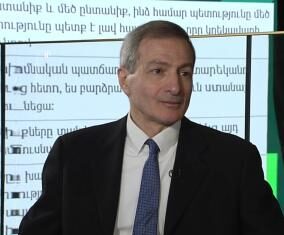By Victoria Ren
Special to the Mirror-Spectator
YEREVAN — The relationship between France and Armenia is a compelling narrative woven from threads of history, culture and shared values. This friendship manifests itself in various forms and locations, from using common words such as “merci,” to the construction of remarkable buildings like the Paul Eluard Francophone Center in Stepanakert, where a visiting European chef brought their expertise in French cuisine, or small yet significant places such as the restaurant Aux Délices Arméniens near the central train station in Cannes.
The geographical reach of this relationship is as extensive as the investments made by France throughout Armenia. According to the analytics firm CEIC Data, French foreign direct investment (FDI) in Armenia was at its lowest in 2019, amounting to 99 million drams ($256,000), down from its peak in 2016 at 461 million drams ($1.9 million); currently, it averages at around 128 million ($330,000). Previously, France had been the second-biggest investor in Armenia after the Russian Federation. Statistics show that the United Arab Emirates has now taken the leading position.
The Chamber of Commerce and Industry (CCI) France Arménie reports that more than 100 French companies have launched operations in Armenia since its independence. These include major players like CBA Bank (Crédit Agricole), Amundi, Yerevan Brandy Company (Pernod Ricard), Veolia, and Bureau Veritas, among others, each contributing to the French influence there while bringing their unique expertise.
Beyond economics and politics, the bond between France and Armenia is sustained by a web of educational, cultural and humanitarian efforts. Institutions such as the French University in Armenia (Université Française en Arménie) and the Anatole France French School (Lycée Français Anatole France) offer students a unique education, encouraging bilingualism and expanding their cultural horizons. Organizations including Erasmus+ and AVC (Armenian Volunteer Corps) facilitate exchanges and volunteer programs, fostering deeper connections between the two nations. Currently, there are 17 AVC volunteers of French origin residing in Armenia, spanning a wide age range, from 20 to 70.











